Introduction: Why Quick Lunches Matter
In today's fast-paced world, finding time to prepare and enjoy a nutritious meal can be challenging. Quick lunches offer multiple benefits that cater to modern lifestyles, making them essential for maintaining energy and productivity.
- Time Efficiency: Quick lunches save valuable time for both individuals and families. With limited time during work breaks or lunch periods, having a meal that can be prepared and consumed quickly is crucial.
- Nutritional Balance: Quick lunch ideas can be designed to include all necessary food groups, ensuring balanced nutrition despite a tight schedule. Proper nutrition is essential for maintaining energy levels, focus, and overall health.
- Cost-Effective: Preparing quick lunches at home can significantly reduce daily expenses compared to eating out. Home-cooked meals can be both economical and healthier, making budget management easier.
- Dietary Flexibility: Quick lunch options can be tailored to fit various dietary needs and preferences, from vegetarian and vegan to gluten-free and low-carb diets. This flexibility allows everyone to enjoy a satisfying meal without compromising their dietary requirements.
- Reducing Food Waste: Utilizing leftovers or simple ingredients helps minimize food waste. By incorporating versatile ingredients, quick lunches encourage more responsible food consumption.
- Work-Life Balance: The ability to prepare and eat lunch swiftly improves work-life balance. This allows individuals to allocate more time for relaxing activities or social interactions, enhancing overall well-being.
"Busy schedules shouldn't compromise the quality of your meals. Quick lunches ensure you get the nutrients and energy you need without the hassle."
List of essential qualities:
- Simplicity: Easy to prepare and minimal cooking required.
- Portability: Convenient to pack and carry.
- Taste: Flavorful and enjoyable.
In an environment where time is often a limiting factor, quick lunches bridge the gap between convenience and health. This ensures optimal performance in professional, academic, and personal spheres. Being informed about the benefits and features of quick lunches empowers better decision-making regarding daily nutrition. Quick and tasty lunch ideas ensure that everyone is well-nourished and ready to tackle their day.
Mason Jar Salads: Fresh and Customizable
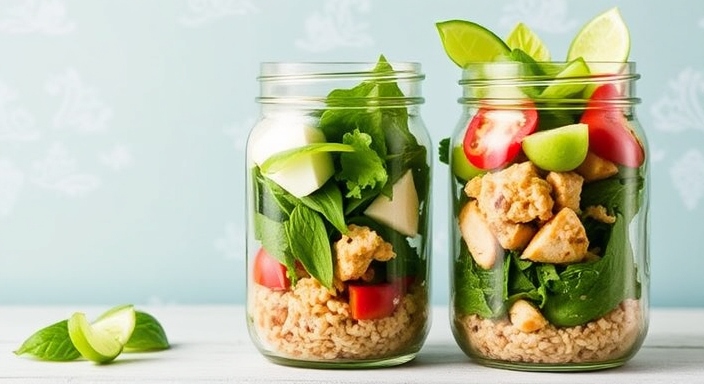
Mason jar salads offer a perfect solution for individuals seeking fresh and customizable lunch options. These portable meals are not only visually appealing but also practical for those who have busy schedules. They allow for easy layering of ingredients, which helps keep the salad components crisp and flavorful until mealtime.
Essential Ingredients
- Base Greens: Choose sturdy greens like spinach, kale, or romaine lettuce that will hold up well in the jar.
- Proteins: Add a source of protein such as grilled chicken, tofu, hard-boiled eggs, or chickpeas.
- Vegetables: Incorporate a variety of colorful, crunchy vegetables like bell peppers, cucumbers, cherry tomatoes, and shredded carrots.
- Grains: For added texture and nutritional value, include cooked quinoa, brown rice, or farro.
- Cheese and Nuts: Enhance the flavor with crumbled feta, shredded cheddar, or a sprinkle of nuts like almonds or walnuts.
- Dressings: Keep the dressing at the bottom to avoid sogginess. Light vinaigrettes or creamy dressings are great choices.
How to Layer Mason Jar Salads
- Dressing: Start with your chosen dressing at the bottom of the jar.
- Hearty Veggies: Next, add hearty vegetables like carrots, cucumbers, and bell peppers that can handle being in the dressing.
- Grains and Proteins: Layer cooked grains and protein over the vegetables.
- Cheese and Nuts: Follow with cheeses and nuts for added richness and crunch.
- Greens: Top it all with your selected leafy greens.
- Seal and Store: Screw on the jar lid tightly and refrigerate until ready to eat.
Tips for Customization
- Dietary Preferences: Adapt the salads to meet dietary restrictions by choosing vegan proteins, gluten-free grains, or dairy-free cheeses.
- Seasonal Ingredients: Take advantage of seasonal produce for the freshest and most flavorful salads.
- Batch Prep: Prepare several jars at once to enjoy different salad combinations throughout the week.
Benefits of Mason Jar Salads
With mason jar salads, the ingredients stay fresh longer, and they can be easily transported to work, school, or wherever your day takes you. This meal prep method helps ensure a healthy and balanced diet without the hassle of daily preparation.
By preparing mason jar salads, one can enjoy a nutritious, customizable, and convenient meal option that fits perfectly into a busy lifestyle.
2. Wraps and Roll-Ups: Versatile and Transportable
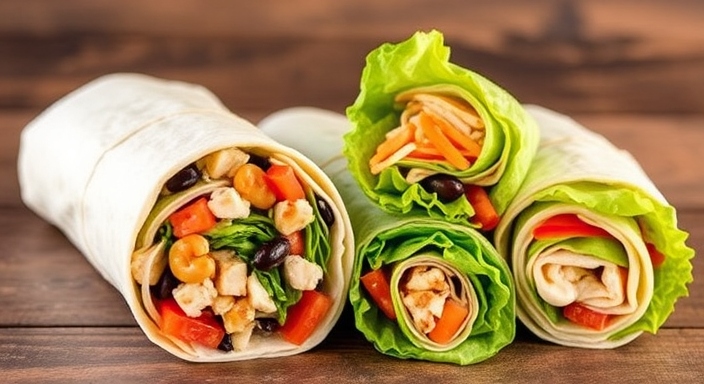
Wraps and roll-ups offer a versatile and transportable option for quick lunches that can be easily customized to suit individual tastes. They are ideal for busy lifestyles and can be prepared ahead of time.
Types of Wraps
- Tortilla Wraps: Use flour or whole grain tortillas for a classic option. They are soft, flexible, and can hold a variety of fillings.
- Lettuce Wraps: For a low-carb alternative, large lettuce leaves make excellent wraps. Romaine, iceberg, or butter lettuce work best.
- Rice Paper Rolls: Popular in Asian cuisine, rice paper rolls are light and airy, perfect for fresh vegetable and protein fillings.
Filling Ideas
-
Protein Options:
- Diced chicken breast
- Grilled shrimp
- Black beans
- Tofu slices
-
Vegetable Choices:
- Julienned carrots
- Sliced bell peppers
- Shredded cabbage
- Avocado slices
-
Additional Ingredients:
- Hummus
- Guacamole
- Salsa
- Cheese slices
Assembly Tips
- Spread a Base: Start with a spread such as hummus, guacamole, or cream cheese to provide moisture and flavor.
- Layer Fillings: Add protein first, followed by vegetables. Ensure even distribution for balanced bites.
- Roll Tightly: Folding in the sides as you roll ensures that the wrap stays together and contents do not spill out.
Storage and Transport
- Wrap Individually: Use plastic wrap or aluminum foil to keep wraps together and maintain freshness.
- Use Airtight Containers: Choose containers that fit wraps snugly to prevent movement and maintain structural integrity.
- Refrigerate: Store in the refrigerator until ready to eat to keep ingredients fresh.
Serving Suggestions
- Dipping Sauces: Serve wraps with dips like balsamic vinaigrette, tzatziki, or flavored yogurt for added zest.
- Pair with Sides: Complement wraps with a side salad, fruit, or a small bowl of soup for a well-rounded meal.
Wraps and roll-ups epitomize convenience and customization, making them an excellent choice for anyone looking to enjoy a quick, easy, and delicious lunch.
3. DIY Bento Boxes: Balanced and Fun

DIY Bento boxes offer a creative and practical way to prepare balanced and fun meals. These compact, compartmentalized containers not only help in portion control but also make lunchtime an enjoyable experience. Easy lunch ideas come to life with Bento boxes, providing a mix of proteins, carbs, and vegetables.
Components for a Balanced Bento Box
-
Proteins:
- Grilled chicken breast
- Hard-boiled eggs
- Tofu cubes
- Sliced turkey
- Beans or legumes
-
Carbohydrates:
- Brown rice
- Whole-grain pasta
- Quinoa
- Sweet potato wedges
- Whole-grain bread
-
Vegetables:
- Cherry tomatoes
- Cucumber slices
- Steamed broccoli
- Bell pepper strips
- Carrot sticks
-
Fruits:
- Apple slices
- Grapes
- Orange segments
- Berries
- Dried fruits
-
Extras:
- Cheese cubes
- Nuts and seeds
- Hummus or yogurt dip
- Seaweed sheets
- Pickled vegetables
Steps to Assemble a Bento Box
- Choose a Container: Select a Bento box with multiple compartments to keep foods separate and appealing.
- Prepare Ingredients: Cook proteins, carbohydrates, and vegetables as needed. Chop vegetables and fruits into bite-sized pieces.
- Arrange Neatly: Place each ingredient into its designated compartment. Ensure that the box is visually appealing with a colorful variety.
- Add Extras: Incorporate small items such as cheese, nuts, or dips to enhance flavor and nutrition.
- Seal and Store: Close the Bento box securely and store it in the refrigerator until ready to eat.
Benefits of DIY Bento Boxes
- Portion Control: Compartmentalized containers limit overeating.
- Nutritious Balance: Ensures a mix of proteins, carbohydrates, and vegetables.
- Variety: Adds excitement to meals with different ingredients and flavors.
- Convenience: Easy to prepare and perfect for busy schedules.
- Eco-Friendly: Reduces the need for disposable lunch packaging.
DIY Bento boxes make every lunch a delightful, balanced, and fun experience, catering to diverse tastes and dietary preferences.
4. Instant Pot Soups: Warm and Satifying
Instant Pot soups offer a warm, satisfying, and quick solution for lunch. Utilizing an Instant Pot not only saves time but also enhances flavors. Here, readers will discover how to prepare three delicious soup recipes that can cater to any taste preference.
Vegetable Soup
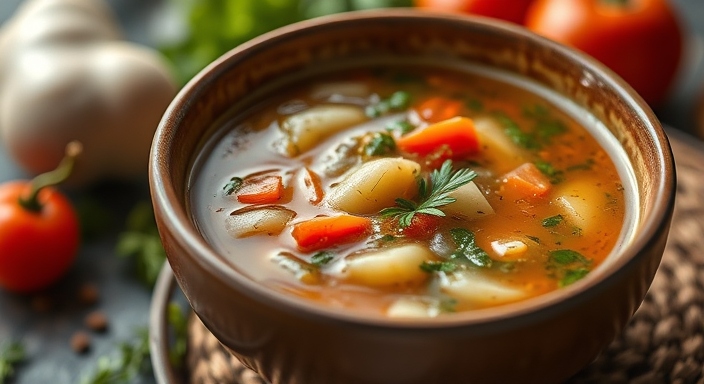
Vegetable soup is a healthy and hearty choice. This dish features a blend of colorful vegetables and robust seasonings, creating a nutrition-packed meal.
Ingredients:
- 2 cups of chopped carrots
- 1 cup of diced celery
- 1 cup of chopped onions
- 2 cups of diced tomatoes
- 4 cups of vegetable broth
- 1 cup of green beans
- 1 cup of corn kernels
- 1 tsp of garlic powder
- 1 tsp of dried basil
- Salt and pepper to taste
Directions:
- Add all prepared vegetables into the Instant Pot.
- Pour vegetable broth over the vegetables.
- Add garlic powder, dried basil, salt, and pepper.
- Secure the lid and set the Instant Pot to cook on high pressure for 10 minutes.
- Perform a quick release, and once the pressure is fully released, open the pot and stir.
Chicken Noodle Soup
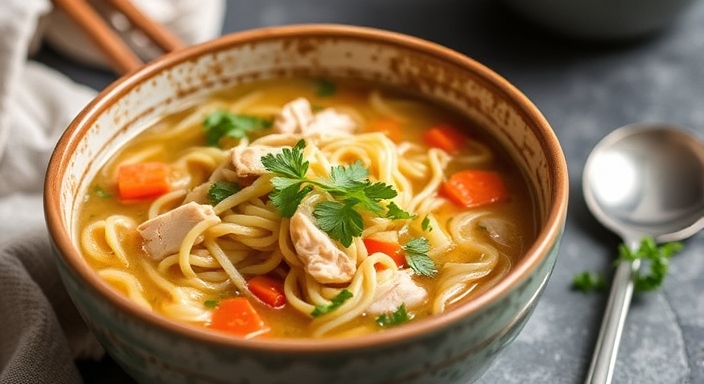
A classic favorite, the chicken noodle soup is comforting and protein-rich. This recipe balances tender chicken pieces, wholesome vegetables, and soft noodles.
Ingredients:
- 2 cups of cooked, shredded chicken breast
- 1 cup of diced carrots
- 1 cup of diced celery
- 1 cup of diced onions
- 4 cups of chicken broth
- 1 tsp of thyme
- 2 cups of uncooked egg noodles
- Salt and pepper to taste
Directions:
- Place the shredded chicken, carrots, celery, and onions in the Instant Pot.
- Add chicken broth and thyme to the mixture.
- Set the Instant Pot to cook on high pressure for 6 minutes.
- Perform a quick release, open the lid, and add the egg noodles.
- Choose the ‘sauté’ function and cook for an additional 5-6 minutes until noodles are tender. Season with salt and pepper as needed.
Creamy Tomato Soup

Creamy tomato soup offers a rich and comforting taste that pairs perfectly with a grilled cheese sandwich.
Ingredients:
- 2 cups of diced tomatoes
- 1 cup of diced onions
- 2 cups of chicken or vegetable broth
- 1 cup of heavy cream
- 2 tbsp of tomato paste
- 1 tsp of dried basil
- Salt and pepper to taste
Directions:
- Add tomatoes, onions, and broth into the Instant Pot.
- Mix in the tomato paste and dried basil.
- Secure the lid and cook on high pressure for 10 minutes.
- Perform a quick release, then blend the contents using an immersion blender or in batches.
- Add the heavy cream and stir to combine. Season with salt and pepper as desired.
These Instant Pot soups make lunchtime simple and enjoyable for everyone seeking quick and easy lunch ideas.
5. Veggie-Packed Pasta Salads: Nutritious and Filling
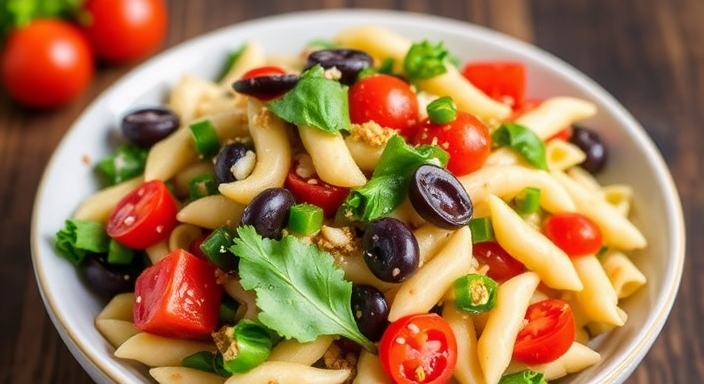
Pasta salads brimming with vegetables make an excellent choice for quick and tasty lunches. Not only are they easy to prepare, but they also provide a substantial nutritional boost. Here’s how to create veggie-packed pasta salads that are both satisfying and wholesome.
Ingredients
- Whole-wheat or gluten-free pasta: Offers more fiber and nutrients compared to regular pasta.
- Fresh vegetables: Cherry tomatoes, bell peppers, cucumbers, red onions, and broccoli.
- Leafy greens: Spinach, arugula, or kale.
- Protein options: Chickpeas, black beans, grilled chicken, or tofu.
- Healthy fats: Avocado slices, olives, or nuts.
- Flavor enhancers: Fresh herbs like basil or parsley, lemon juice, and a drizzle of olive oil.
Preparation Steps
- Cook the pasta: Follow package instructions, making sure not to overcook it to avoid a mushy texture.
- Chop the vegetables: Dice the cherry tomatoes, bell peppers, cucumbers, and red onions into bite-sized pieces.
- Steam or roast lightly tougher vegetables like broccoli.
- Combine ingredients: In a large bowl, mix the cooked pasta, fresh veggies, and leafy greens.
- Add protein and fats: Toss in your chosen protein source, avocado, olives, or nuts.
- Season and dress: Sprinkle with fresh herbs, squeeze in some lemon juice, and drizzle with olive oil. Season with salt and pepper to taste.
Tips for Customization
- Opt for seasonal vegetables to keep the pasta salad exciting and cost-effective.
- Add a splash of balsamic vinegar or a touch of mustard to the dressing for extra flavor.
- Sprinkle nutritional yeast for a cheesy taste without the dairy.
- For a Mediterranean twist, include sun-dried tomatoes, feta cheese, and pine nuts.
Storage and Serving
- Pasta salads can be made in advance and stored in the refrigerator for up to three days.
- Keep the dressing separate to maintain freshness and avoid sogginess if preparing ahead of time.
- Serve pasta salads chilled or at room temperature, making them perfect for packed lunches or picnics.
Health Benefits
- Loaded with vitamins, minerals, and antioxidants from fresh vegetables.
- Fiber from whole-wheat pasta and vegetables aids digestion and keeps one feeling full longer.
- Balanced meals with protein, healthy fats, and complex carbohydrates support steady energy levels.
By integrating veggie-packed pasta salads into one’s meal rotation, anyone can enjoy a nutritious, filling, and delicious lunch effortlessly.
Meal Prep Tips for Busy Days
Meal prepping can be a game-changer for those with packed schedules. Keeping meal prep simple, efficient, and organized ensures that delicious and nutritious meals are always ready to grab. Below are some practical tips to make the process smoother:
- Choose Recipes Wisely: Opt for dishes that are easy to prepare in bulk and store well, such as grain bowls, pasta salads, and sheet pan meals.
- Create a Weekly Plan: Sit down once a week to outline each meal, taking into account busy days and aligning meals with ease of preparation.
- Make a Shopping List: Write a detailed grocery list based on the meal plan to ensure nothing is forgotten, saving multiple trips to the store.
- Batch Cooking: Cook ingredients in large quantities, such as grains, proteins, and vegetables, then mix and match them throughout the week.
- Use Multi-Purpose Ingredients: Select ingredients that can be used in multiple recipes to save time, such as roasted vegetables for salads, wraps, and bowls.
- Invest in Quality Containers: Purchase a variety of airtight, microwave-safe containers for easy storage and reheating without losing food quality.
- Label and Date: Clearly label each container with the meal name and preparation date to quickly identify meals and manage freshness.
- Prep Snacks: Have ready-to-eat snacks like cut vegetables, hummus, or fruit portions to curb hunger between meals without extra prep.
- Freeze Extras: Freeze portions of meals for later weeks, reducing the cooking load on future busy days.
- Clean as You Go: Maintain a tidy workspace by cleaning utensils and surfaces as you prepare, preventing a pile of dishes at the end.
Incorporating these tips into one’s routine can significantly minimize daily meal preparation stress, making it feasible to enjoy quick and tasty lunch options every day. Consistency is key to mastering meal prep, eventually making it a seamless part of a busy lifestyle.
Ingredient Substitutions for Dietary Needs
Incorporating ingredient substitutions can transform traditional recipes into diet-friendly meals. For those with various dietary restrictions or preferences, here are some helpful swaps to make lunches both healthy and delicious.
Gluten-Free Substitutions
- Flour: Replace wheat flour with almond flour, coconut flour, or gluten-free all-purpose flour.
- Bread: Use gluten-free bread, lettuce wraps, or rice paper for sandwiches and wraps.
- Pasta: Opt for gluten-free pasta made from rice, quinoa, or legumes.
Dairy-Free Alternatives
- Milk: Substitute cow’s milk with almond milk, soy milk, oat milk, or coconut milk.
- Cheese: Choose dairy-free cheese made from nuts, soy, or plant-based ingredients.
- Yogurt: Use coconut yogurt, almond yogurt, or soy yogurt in place of traditional yogurt.
Vegetarian and Vegan Options
- Protein: Replace meat with tofu, tempeh, seitan, or legumes such as chickpeas and lentils.
- Eggs: Use flaxseed meal mixed with water or mashed bananas as an egg replacement in baking.
- Butter: Substitute with plant-based margarine, coconut oil, or olive oil.
Low-Carb and Keto-Friendly Choices
- Rice: Opt for cauliflower rice or shirataki rice instead of white rice.
- Bread and Wraps: Use keto-friendly bread, lettuce leaves, or collard greens.
- Pasta: Substitute with zucchini noodles (zoodles), spaghetti squash, or shirataki noodles.
Low-Sodium and Heart-Healthy Ingredients
- Salt: Use herbs, spices, and lemon juice to season foods without added sodium.
- Chicken Broth: Replace with low-sodium or homemade broth.
- Canned Vegetables: Opt for fresh or frozen vegetables to reduce sodium intake.
Nut-Free Substitutes
- Nut Butters: Use sunflower seed butter, tahini, or soy nut butter.
- Flour: Replace almond flour with oat flour or sunflower seed meal.
- Milk: Substitute with oat milk, rice milk, or coconut milk.
By implementing these ingredient substitutions, one can create quick, tasty, and compliant meals that cater to various dietary needs, ensuring every lunch is enjoyable and nutritious.
Conclusion: Enjoying Your Lunch WIthout the Stress
Navigating everyday meals can be simplified by integrating easy lunch ideas into your routine. These strategies help make lunchtime more manageable:
-
Preparation is Key:
- Meal prepping on weekends saves time during the week.
- Utilizing storage containers helps keep ingredients fresh.
-
Planning Diverse Menus:
- Incorporate a mix of proteins, vegetables, and grains.
- Rotating recipes prevents monotony and keeps meals exciting.
-
Quick Recipes:
- Opt for recipes that can be made in 30 minutes or less.
- Use pre-cut vegetables and ready-to-eat proteins like rotisserie chicken.
-
Time-Saving Tools:
- Invest in a good set of knives and cutting boards for efficiency.
- Small kitchen appliances like slow cookers or pressure cookers expedite cooking.
-
Healthy Eating Focus:
- Aim for a balanced diet with vitamins and nutrients.
- Consider whole foods over processed items for better health outcomes.
-
Creative Leftovers:
- Transform dinner leftovers into new lunches, such as soups or salads.
- Keeping a versatile pantry aids in repurposing meals quickly.
-
Simple Storage Solutions:
- Label and date containers to track meals.
- Stackable containers maximize fridge space and organization.
Adopting these practices can streamline lunchtime experiences, making it a stress-free part of the day. Enjoying nutritious and tasty meals becomes attainable by keeping convenience and variety in mind. Everyone can benefit from the ease and simplicity of thoughtful lunch planning, turning mid-day eating into a pleasurable and healthy habit.